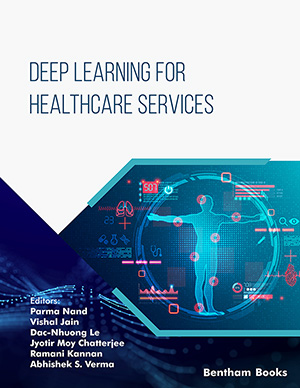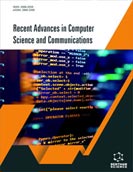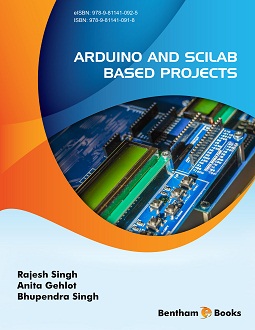Book Volume 2
Preface
Page: i-ii (2)
Author: Parma Nand, Vishal Jain, Dac-Nhuong Le, Jyotir Moy Chatterjee, Ramani Kannan and Abhishek S. Verma
DOI: 10.2174/9789815080230123020001
Role of Deep Learning in Healthcare Industry: Limitations, Challenges and Future Scope
Page: 1-22 (22)
Author: Mandeep Singh*, Megha Gupta, Anupam Sharma, Parita Jain and Puneet Kumar Aggarwal
DOI: 10.2174/9789815080230123020003
PDF Price: $15
Abstract
Nowadays, the acquisition of different deep learning (DL) algorithms is becoming an advantage in the healthcare sector. Algorithms like CNN (Convolution Neural Network) are used to detect diseases and classify the images of various disease abnormalities. It has been proven that CNN shows high performance in the classification of diseases, so deep learning can remove doubts that occur in the healthcare sector. DL is also used in the reconstruction of various medical diagnoses images like Computed Tomography and Magnetic Resonance Imaging. CNN is used to map input image data to reference image data, and this process is known as the registration of images using deep learning. DL is used to extract secrets in the healthcare sector. CNN has many hidden layers in the network so that prediction and analysis can be made accurately. Deep learning has many applications in the healthcare system, like the detection of cancer, gene selection, tumor detection, recognition of human activities, the outbreak of infectious diseases, etc. DL has become famous in the field of healthcare due to its open data source. In the case of the small dataset, CNN becomes an advantage as it does not provide an excellent way to statistical importance. Deep Learning is a technique that includes the basis of ANN (Artificial neural networks), appears as a robust tool for machine learning, and encourages recasting artificial intelligence. Deep learning architecture has more than two hidden layers, as in ANN; it is only one or two. Therefore, this chapter represents a survey of the role of deep learning in the healthcare industry with its challenges and future scope.
Generative Adversarial Networks for Deep Learning in Healthcare: Architecture, Applications and Challenges
Page: 23-47 (25)
Author: Shankey Garg* and Pradeep Singh
DOI: 10.2174/9789815080230123020004
PDF Price: $15
Abstract
Deep Learning is a new generation of artificial neural networks that have transformed our daily lives and has impacted several industries and scientific disciplines in recent years. Recent development in deep learning provides various significant methods to obtain end-to-end learning models from complex data. Generative Adversarial Networks give the idea of learning the deep representations without extensively interpreting the training data. The generative adversarial network involves the generative modeling approach that uses the deep learning approach. The chapter is broadly divided into the following sections as (1) Insights of deep learning & the generative adversarial networks, (2) GAN’s representative variants, training methods, architecture, and mathematical representation, and (3) Efficacy of GAN in different applications. This chapter will gain the recent work done in GAN and implement this technique in the different deep learning applications for healthcare. Here, we will also analyze some of the future perspectives and trends in the forthcoming time.
Role of Blockchain in Healthcare Sector
Page: 48-62 (15)
Author: Sheik Abdullah Abbas*, Karthikeyan Jothikumar and Arif Ansari
DOI: 10.2174/9789815080230123020005
PDF Price: $15
Abstract
The domain of bio-medical engineering is facing significant challenges and issues due to data management, data attribution, data security, data availability and privacy. The mechanism of blockchain corresponds to a time-stamped set of data records that is maintained and managed by a cluster/group of the computer system. The collection of cluster groups is secured and protected by cryptographic values, which are often said to be the chains. The growth of blockchain has progressed in a variety of applications in terms of asset management, IoT, smart devices, supply chains, public data validations, and personal identification. Even though the growth has progressed in different emerging disciplines, the impact of blockchain in technology-based biomedical engineering created a vast difference and incorporation in various fields of operation. In a medical data management system, an old audit trail is mostly needed to perform data operations such as insert, delete, and update. Blockchain is, therefore, suitable for the process concerning fixed ledger to record and update critical information services. This chapter completely focuses on the role of blockchain in biomedical engineering applications.
Brain Tumor Detection Based on Different Deep Neural Networks - A Comparison Study
Page: 63-89 (27)
Author: Shrividhiya Gaikwad, Srujana Kanchisamudram Seshagiribabu, Sukruta Nagraj Kashyap, Chitrapadi Gururaj* and Induja Kanchisamudram Seshagiribabu
DOI: 10.2174/9789815080230123020006
PDF Price: $15
Abstract
Glioblastoma, better known as Brain cancer, is an aggressive type of cancer that is fatal. Biomedical imaging technology now plays a prominent part in the diagnosis of cancer. Magnetic resonance imaging (MRI) is among the most efficient methods for detecting and locating brain tumors. Examining these images involves domain knowledge and is prone to human error. As computer-aided diagnosis is not widely used, this is one attempt to develop different models to detect brain tumors from the MRI image. In this chapter, we have carried out a comparison between three different architectures of Convolutional Neural Networks (CNN), VGG16, and ResNet50, and visually represented the result to the users using a GUI. Users can upload their MRI scans and check the tumor region if they have been diagnosed with cancer. Initially, pre-processed data is taken as input, and the features are extracted based on different model approaches. Lastly, the Softmax function is used for the binary classification of the tumor. To further validate the methodology, parameters like Accuracy, Recall, Precision, Sensitivity, Specificity, and f1 score are calculated. We have observed up to 86% of accuracy in the CNN model, whereas VGG16 and ResNet50 had an accuracy of 100% for our test dataset and 96% for our validation dataset.
A Robust Model for Optimum Medical Image Contrast Enhancement and Tumor Screening
Page: 90-111 (22)
Author: Monika Agarwal, Geeta Rani*, Vijaypal Singh Dhaka and Nitesh Pradhan
DOI: 10.2174/9789815080230123020007
PDF Price: $15
Abstract
The use of medical imaging techniques have improved the correctness of disease screening and diagnosis. But, the quality of these images is greatly affected by real-time factors such as the type of machinery used, the position of a patient, the intensity of light, etc. The poorly maintained machines, incorrect positioning of patients, and inadequate intensity of light lead to low contrast and poor-quality medical images that work as hindrances in examining medical images. Thus, there is a need to upgrade the features of medical images. Researchers applied histogram equalization for contrast enhancement. However, it improves the visual appearance of medical images but faces the difficulties of over-enhancement, noise, and undesirable artifacts. Also, these techniques report low accuracy in tumor detection. Therefore, we propose an efficient model for medical image contrast enhancement and correct tumor prediction. The model performs segmentation, weighted distribution, gamma correction, and filtering to improve the visual appearance of MRI images. Further, it employs the optimum feature extraction for the correct detection of regions infected with tumors. Furthermore, findings obtained in a simulated environment demonstrate that our proposed model outperforms current models.
Introduction
This book highlights the applications of deep learning algorithms in implementing big data and IoT enabled smart solutions to treat and care for terminally ill patients. It presents 5 concise chapters showing how these technologies can empower the conventional doctor patient relationship in a more dynamic, transparent, and personalized manner. The key topics covered in this book include: - The Role of Deep Learning in Healthcare Industry: Limitations - Generative Adversarial Networks for Deep Learning in Healthcare - The Role of Blockchain in the Healthcare Sector - Brain Tumor Detection Based on Different Deep Neural Networks Key features include a thorough, research-based overview of technologies that can assist deep learning models in the healthcare sector, including architecture and industrial scope. The book also presents a robust image processing model for brain tumor screening. Through this book, the editors have attempted to combine numerous compelling views, guidelines and frameworks. Healthcare industry professionals will understand how Deep Learning can improve health care service delivery.






















